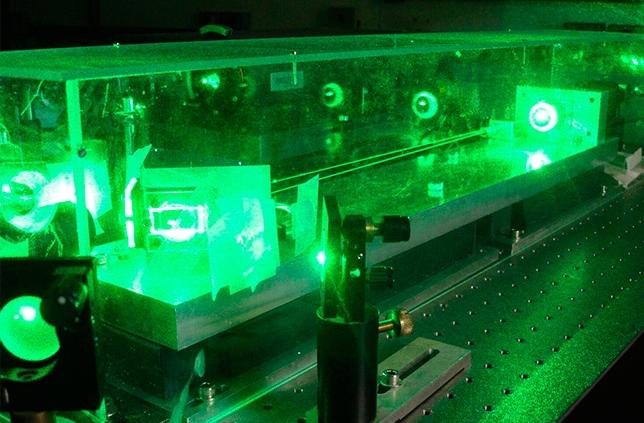Scientists at the University of São Paulo's Physics Institute (IFUSP) have demonstrated the entanglement of six light waves generated by an optical parametric oscillator (OPO). Entanglement — a phenomenon that occurs when groups of particles or waves interact in such a way that the quantum state of each particle or wave cannot be described independently of the others — could be used to transmit information between future quantum devices.
In previous experiments, the team entangled two and three modes using the OPO. The team’s current experiments have doubled the space available for information to be encoded.

Record number of entangled light waves from one laser, set by Brazilian researchers, could help make quantum computing feasible. Courtesy of Marcelo Martinelli (IFUSP).
To produce a six-wave entanglement, the team shone a green laser into a cavity containing a potassium-titanyl-phosphate crystal. When the light beam hit the crystal, it generated two other fields, which maintained the characteristics of the laser, that is, intense monochrome light with well-defined frequencies.
“The system therefore now consists of three intense fields,” said Professor Marcelo Martinelli. “Each intense field couples a pair of extremely weak fields, so that the six fields are coupled to the main field. The correlations between them are stronger than the correlations that are feasible if independent lasers are used.”
When the team measured fluctuations in the intensities and phases of the six modes, they found a statistical correlation in the values of these two parameters that was indicative of entanglement.
“Our platform is capable of generating a massive entanglement of many optical modes with different but well-defined frequencies, as if connecting the nodes of a large network. The quantum states thus produced can be controlled by a single parameter: the power of the external laser that pumps the system."
The information that can be encoded by a single wave is limited by the uncertainty principle. In this case, the wave amplitude and phase behave as analogs of particle position and velocity.
The six waves comprise a set. When information is obtained from one wave, information is obtained on the entire system. When one wave is changed, the entire system is changed.
“With entanglement, part of the information in each particular wave is lost, but the global information in the system is preserved, in a shared form,” Martinelli said. “Sharing means that when we observe a single wave, we’re informed about the other five at the same time. Each beam goes to a detector, and this distribution of the information into independent units boosts the processing speed."
The device that generated the entangled states — the OPO — consists of a small crystal between two mirrors. The crystal is 1 cm long, and the distance between the mirrors is less than 5 cm. Because cooling is a necessary condition for the process, the crystal and mirrors are placed inside an aluminum box in a vacuum to avoid condensation and to prevent the system from freezing.
Calculations by the team show that for one laser, one crystal, and one cavity, a maximum of six modes can be entangled. However, the researchers are working to overcome this limit by connecting multiple cavities and lasers, an advance that could allow them to entangle 12, 18, or more modes. Such mode entanglement could allow the linking of quantum devices that operate at different frequencies, a capability that would be necessary to allow large numbers of quantum devices to interact, for example, in a future quantum internet.
“Entanglement is a property that involves quantum correlations between distinct systems,” Martinelli said. “These correlations are a major asset that can make quantum computers superior to traditional electronic computers in performing tasks such as simulations or prime number factoring, a critical operation for data security in today’s world. For this reason, the creation of systems with multiple entangled components is an important challenge in implementing the ideas of quantum information theory.”
The research was published in Physical Review Letters (doi:10.1103/PhysRevLett.121.073601) and in Physical Review A (doi:10.1103/PhysRevA.98.023823).